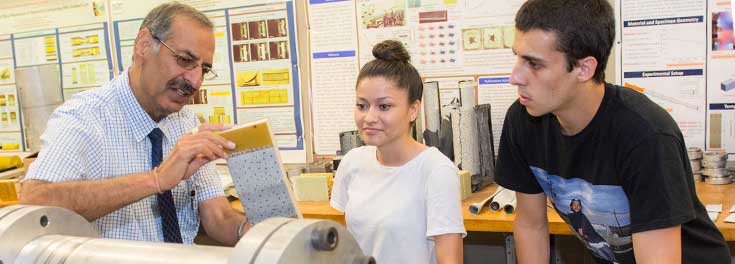
How much force does it take to shatter a Humvee, a soldier’s body armor, or a submarine?
Professor Arun Shukla in the College of Engineering is finding answers to those questions and more as he studies how and why things break apart. A world leader in fracture and experimental mechanics, Shukla—the Simon Ostrach Professor of Mechanical Engineering at URI—has been working with the American government since the early 1980s to create stronger materials that can withstand damage from explosions and other catastrophic events. Most recently, he has conducted experiments for the U.S. Department of Homeland Security and the U.S. Department of Defense.
There is no better place in the world to do the kind of research we do, especially underwater structure analysis. The research is far-reaching and rewarding.
“Our objective is to find better ways to protect soldiers and civilians—and make our infrastructure stronger and more durable,’’ says Shukla. “As the world becomes more violent, this type of research is crucial to make us safer.’’
In his laboratory in the Kirk Center for Advanced Technology on the Kingston campus, he and his students—undergraduates and graduates—simulate bomb blasts and other explosions in two devices: a huge pressurized steel water capsule and a 33-foot aluminum shock tube.
With that equipment he creates a controlled explosive environment so he can test how materials stand up to blasts—and also ensure that his students are doing safe experiments.
The shock tube simulates the rush of high-pressure gases from an exploding bomb to test materials. Helium is pumped into the tube to break a covering, then the gases race down the tube at three to four times the speed of sound and hit the material at the end.
The 7-foot-tall, 1,800-gallon water capsule simulates the pressure deep in the ocean to measure how underwater shock waves and explosions affect materials and structures at that depth.
Both devices evaluate different materials and structures. In a study for Homeland Security using the shock tube, Shukla examined how blasts damage glass windows and buildings. And in a study for the U.S. Navy, he is looking at how structures in submarines collapse from water pressure and blasts.
Shukla built the shock tube with Carl-Ernst Rousseau, now chair of Mechanical, Industrial and Systems Engineering at URI. Shukla designed the water capsule, which was built in Virginia and shipped to URI three years ago. Both devices loom large in Shukla’s Dynamic Photomechanics Laboratory, where the equipment hums steadily as it readies for the experiments.
“This research equipment is unique and highly suited for studying catastrophic events,’’ says Shukla. “URI’s engineering college is doing cutting-edge research that is highly valuable for the state, the country, and the world.’’
His students agree. “I feel lucky to be studying under Dr. Shukla,’’ says Helio Matos, a doctoral student in mechanical engineering. “There is no better place in the world to do the kind of research we do, especially underwater structure analysis. The research is far-reaching and rewarding.’’
